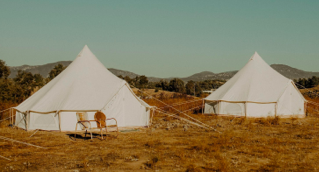ENVÍO GRATIS + SIN IMPUESTOS SOBRE LAS VENTAS
Menú
-
- Comercio
- Tiendas de campaña
- Wall Tents
- Tienda de lona
- Carpas tipo campana
- Carpas para festivales
- Tiendas de caza
- Tiendas de yurta
- Carpas familiares
- Tienda de observación de estrellas
- Tiendas de campaña
- Regalos para acampar
- Tiendas terrestres
- Estufas de tienda
- Tienda de campaña para 4 personas
- 6 Person Tents
- Tienda de campaña para 8 personas
- 12 Person Tents
- Tienda de campaña para 6 personas
- Equipo de campamento
- Sillas de camping
- Shade Canopy Tents
- Camping Fans
- Servicios
- Acerca de
- Contact Us
- Reviews
-
- Entrar

Free Shipping

Pay No Sales Tax
30-Month Warranty
ENVÍO GRATIS + SIN IMPUESTOS SOBRE LAS VENTAS
Tiendas de campaña
Acerca de
Comercio


La lista de LiT
Ideas + recursos para acampar y glamping
Designed for Travel: The Evolution of the Duffel Bag
3 lectura mínima
Ever wonder how the duffelbag got its name? With its iconic barrel shape and versatile functionality, duffel bags have had quite the journey. Especially when you consider how far they’ve come from their namesake town of Duffel, Belgium. Except, they weren't referred to as “duffel bags” back then, of course.
So what’s the story of duffel bags? Join us as we break down the rich history and the evolution of the duffel bag.
The History of the Duffel Bag

The Duffel Bag’s Belgium Origins
Before they became known as “duffel bags,” they were not even bags at all. In fact, the word “duffel” was merely the type of wool-like fabric the town produced for a variety of things. (For instance, you can still find Duffel coats with toggle-and-rope fastenings).
Eventually, this wool-like duffel fabric was turned into bags too. Not the cylindrical shape we know today, but more of a simple rope-tied pouch. And the duffel bag we know started with sailcloth and sailors.
Duffel, Belgium Sailcloth and Savvy Sailors
The thick wool duffel material was extremely durable and able to withstand wear and tear quite well, making it the fabric of choice for many shapes of bags.
During the 1600s, when Spanish and Portuguese seafarers explored the waves, sailors carried onboard rucksack-like “ditty bags” as luggage made of duffel.
However, while the duffel was rugged, this didn’t work for seafarers, as wet wool was quite heavy.
So, to make do, the sailors patched their bags with spare sailcloth (the very same heavy waxed canvas eventually used to make tents), and discovered it worked pretty well! After all, canvas fabric, especially waxed canvas, is water-resistant and able to withstand brackish waters too.
But, lack of wool aside, that’s how we got the duffel bag as we know it.
The Duffel Bag Join the Military
Eventually, the duffel bag’s durability and practical features caught the eye of the U.S. and British military. As World War I came about, every airman, soldier, and sailor (again) was issued a duffel bag to haul their personal items, sometimes along with a bedroll.
Still very much a “ditty bag” with grommets and a drawstring-like rope closure, they became less of a laundry bag look and more their classic cylindrical shape as World War II came about.
In WWII, the duffel bag (or “Bag, Duffel”) was issued to soldiers. Duffel bags often showcased the officer’s name and serial number.
By now, the duffel was at least cylindrical, but instead of laying longways, it stood on a circular bottom with a flap opening. And it was also during this time, that duffel bags gained straps and woven webbing to support extra weight.
Military duffel bags started as denim, then slowly transitioned to the duck canvas in an olive drab/army green color as a more practical means: camouflage.

William J. Donovan’s Duffle Bag | By The Central Intelligence Agency
Contemporary Duffel Bag Designs
Duffel bags have always been highly functional, but after their military use (including Vietnam), they started to become popular and eventually even fashionable. With plane transportation becoming the norm for the average citizen, duffel bags soon became a go-to piece of travel luggage for flights.
No longer made solely for the military, duffel bags soon transformed into gym and sports bags, transporting accessories like equipment, gear, and shoes. Later, duffel bags were made in modern synthetic fabrics, such as vinyl, polyester, and even ballistic nylons. Duffels even ditched the olive drab to offer a range of colors!
zipper, invented in the early 1900s, finally made its way onto duffel bags too, lending to the horizontal barrel-shaped design. Placed on its side, plastic feet became common as well.
Today, duffel bags generally serve the same purpose, to transport personal belongings. But they can be found with shoe compartments and laptop sleeves, and some even offer wheels.
Duffel Bags: Designed for Travel

A well-made duffel bag makes the best travel companion. Perfect for hauling camp gear, clothes, and more, duffels are now a common piece of luggage used by everyone (not just the military).
If you’re in the market for one, look no further than the Beckel Canvas Weekend Duffel, made with natural fabrics like 18-20 oz. canvas (depending on the chosen color) that stands the test of time. (Polyester duffel bags tend to break down faster.)
At 46 Liters, the War & Peace Bag is spacious, resilient, and rugged, featuring a 2-inch heavy-duty cotton webbing handle, reinforced with leather accents. It also includes adjustable shoulder straps for a carry-on-friendly luggage piece or to simply carry clothes to and from the campsite.
Pair it with the Canvas Dopp Kit (as seen in the photo above) to keep toiletries separate and neatly organized.
Related Resources

LA LISTA ILUMINADA 2 lectura mínima
Ideas para acampar en el patio trasero con niños durante el COVID-19
Acampar en familia durante el coronavirus puede ser una aventura tan grande como acampar en el bos
LA LISTA ILUMINADA 5 lectura mínima
¿Pueden las empresas de glamping sobrevivir a una recesión?
Examinando la resiliencia de las empresas de campings de lujo: El glamping , el primo lujoso del Blogs populares
-
2. Cómo iniciar un negocio de glamping
3. Cree una plataforma con plataforma tipo campana
4. Los mejores baños portátiles para acampar
5. Cómo montar y plegar una tienda de campaña
6. Las mejores estufas para tiendas de campaña: formas de calentar una tienda de lona
7. Ideas de regalos para acampar para personas que lo tienen todo
productos populares
Suscribir
Regístrese para recibir lo último en ventas, nuevos lanzamientos y consejos
CONVIÉRTETE EN UN INFORMATIVO
Periódicamente compartiremos contigo inspiración, lanzamientos de tiendas de campaña, ofertas especiales y notificaciones de eventos.

